Space Housing, Part 3: How We Will Live on Mars
We have already talked about how people will live in space colonies and on the Earth’s natural satellite, the Moon . It is time to discuss how to exist on other planets. It was the turn of Mars.
The red planet is closest to Earth, except for Venus. In just 9 months, you can reach your destination. Mankind is developing technologies that will get to Mars, create a permanent base there, set up mining operations and even terraform this planet in order to simplify the lives of people on it.
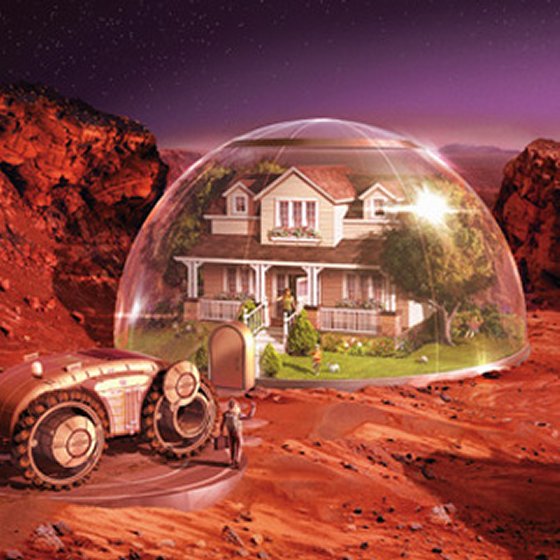
The USSR studied the Red Planet in the framework of the Mars and Phobos programs. The Mars-1 spacecraft, launched on November 1, 1962, was the first to be launched on a flight path to Mars. At a distance of 106 million kilometers from Earth, the device last contacted, but its task was to collect data about the flight itself: the intensity of cosmic radiation, the distribution of meteoric matter, the strength of the Earth’s magnetic fields and the interplanetary medium. The Mars-2 orbiter studied the planet from orbit for more than 8 months. The Mars-3 descent vehicle became the first vehicle to successfully land on the planet's surface, although it shut down after 20 seconds. The Mars-2 and Mars-3 orbiters helped to investigate the properties of the surface and atmosphere of Mars according to the nature of the radiation, to identify thermal anomalies, and to measure the temperature of the north polar cap. The vehicles with serial numbers 4, 5, 6, 7 took photographs of the surface, including color ones, and continued to collect various data about the planet, including the chemical composition of the atmosphere.
')
From 1962 to 1972, NASA sent 10 spacecraft to Mars and Venus as part of the Mariner program. Mariner 4 flew at a distance of 9,846 kilometers from the surface of the planet and became the first to photograph Mars at close range. The devices Mariner 6 and Mariner 7 flew even closer, at a distance of less than 3.5 thousand kilometers from the planet. Mariner 9 was the first artificial satellite of another planet and photographed about 85% of the surface. In the 1970s, NASA launched the Viking program. Two vehicles were sent in 1975 and worked first until 1978, the second until 1980. Descent vehicles took soil samples to analyze for the presence of life.
In 1996, NASA sent a Mars Global Surveyor unmanned research station. In 2005, this station became the first spacecraft to film another device in an extraterrestrial orbit. After almost ten years of work, the connection with the device has been lost.
The Mars rover Sojoner worked on Mars in 1997 for almost three months, from 2004 to 2010 he worked as a Spiritist. Now the planet is being studied by Opportunity , which was supposed to work only 90 days, but has been functioning for several years since January 2004, and Curiosity , which came to the surface in August 2012.
Today, Mars is the most studied planet in the solar system after Earth. But for his colonization to be solved still a lot of questions.

American astronomer Karl Sagan at the layout of the automatic viking station "Viking"
To live on Mars, you need to fly to it. To send people there immediately would be a huge mistake, so it is supposed to deliver various equipment to the planet, which will later allow to deploy residential buildings, modules for growing plants, a rocket fuel plant (you need to return to Earth someday!)
In the USSR in the early 1960s, they began to develop a heavy interplanetary ship. In parallel, two projects were developed. The first Maksimov apparatus with a crew on board had a living compartment, a worker with a gateway for going into outer space, a descent module, an adjustment propulsion system. The Feoktistov spacecraft assumed the assembly of a spacecraft in orbit, a crew of 4 people, a descent vehicle. The project was closed because of the moon race.
In the USA, from 2004 to 2010, they worked on the “Constellation” program, under which they planned manned flights to Mars. One of the targets was the new manned research ship Orion.
The American company SpaceX is working on the Interplanetary Transport System. The project involves the creation of reusable space transport to deliver people to Mars. The system will consist of a returnable launch vehicle, a spacecraft and an interplanetary vehicle for refueling.
One of the main threats of a manned flight to Mars is radiation. Solar flares, guaranteeing an increased dose of radiation, may have to wait in special rooms. Full protection of the spacecraft can greatly weight it, as well as increase the cost of the flight. But there is another way - to create a magnetic field that will need to be turned on during strong solar flares.

It is important to say about the failed program Mars One, which until 2015 was one of the most famous thanks to an open set of people willing to fly to Mars and a huge amount of PR on the Internet, in the media and on television. Five years after starting work on it, it turned out that there was no money, no technical solutions for the project.
Cargo delivery to Mars in any case will remain a rather expensive task. Between the windows for the flight passes 26 months. The flight itself takes 9 months, plus you need time to work out the details, to compile and collect the cargo. Therefore, in order to create a colony, the most autonomous existence of people on the planet is most important.
One of the main problems to be solved is the development of agriculture . For more than fifty years, scientists and cosmonauts have been researching the effects of microgravity on seeds, thinking through the possibilities of creating farms at space stations and other planets. In 1960, together with Belka and Strelka, the seeds of corn, wheat, peas and onions were sent into orbit, and in 1974, the Oasis plant for plant cultivation was installed at the Salyut-4 orbital station.
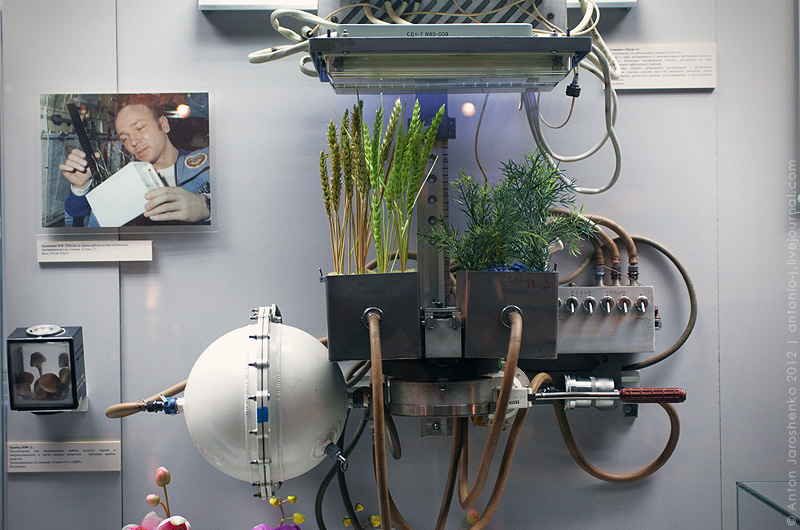
"Oasis-1" in the Memorial Museum of Cosmonautics. A source
Cosmic crop production is not limited to experiments in microgravity. It is necessary to understand how plants will behave in a different soil from the earth and in an atmosphere with a different composition. Meteorite soil, as it was found out in 2014, is suitable for growing asparagus and potatoes, but it must be ground for this purpose. Mars has a lot of sand and dust, it simplifies the task. But there is another problem: heavy metals.
Since 2013, Dutch scientists have grown plants in imitation of the Martian soil. The content of heavy metals in peas, radish, rye and tomatoes turned out to be safe for humans. Research on other crops, such as potatoes, is ongoing.
The atmosphere of Mars is 95% carbon dioxide, which will help maintain vegetation.

Researcher Wager Vamelink inspects plants grown on simulated Martian soil. Photo: Joep Frissel / AFP / Getty Images
In addition to actually feeding people, plants, algae and microorganisms can play a special role in terraforming the planet - creating suitable conditions for human life on it.
Even today, Mars is partially suitable for human life due to a number of characteristics with special equipment, including a pneumatic suit. The day on Mars lasts 24 hours 39 minutes 35. There is a change of seasons on the planet, although on Mars this is twice as long. An atmosphere with a density of 0.007 Earth gives some protection from solar and cosmic radiation. There definitely is ice, and possibly - water in liquid form .
In the process of terraforming it is possible to solve several problems. First, this is an increase in atmospheric pressure, at which water will exist in a liquid form. Now the water on the planet boils at +10 degrees, that is, from the ice turns into steam immediately. Also, with increasing pressure, it will be possible to use an altitude compensation suit instead of spacesuits.
Secondly, on the planet, you can raise the temperature to 10-20 degrees Celsius. Now the average temperature is −50 ° C and ranges from −153 ° C at the pole in winter and to over +20 ° C at the equator at noon.
Thirdly, you need to create a biosphere - to populate the planet with plants, fungi, bacteria.
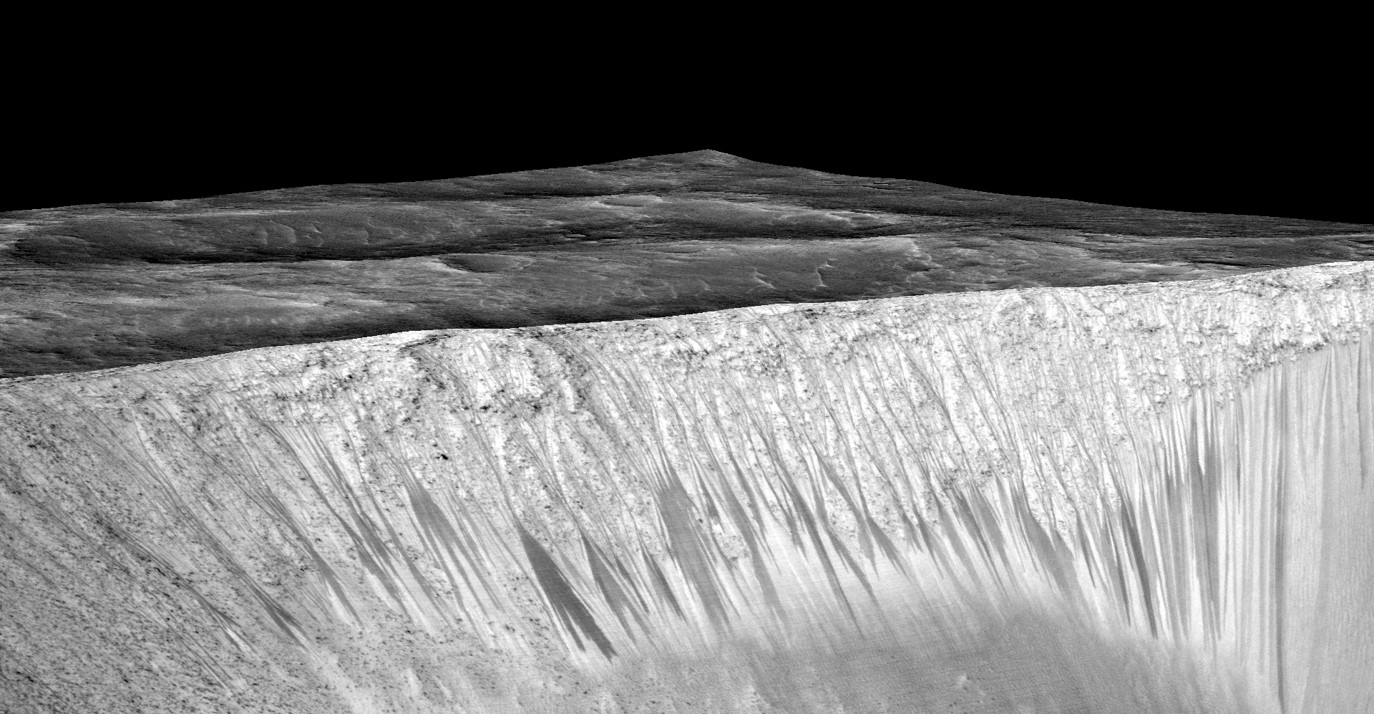
Dark stripes - the estimated flow of liquid water on Mars. Photo: NASA
At the moment there are a number of ways that, as scientists assume, will allow you to change Mars. On the surface of the planet, for example, asteroids can be brought down to warm the atmosphere and fill it with water and gases. Artificial satellites can be placed in orbit, which can focus sunlight on its surface to heat up.
In order to allocate greenhouse gases on Mars and obtain the necessary substances in large volumes from those already on the planet, they propose to use extremophiles - these are living beings, including bacteria and microorganisms, which are able to live and reproduce in extreme conditions. Some 34 species of lichens and cyanobacteria were able to adapt to the simulated Martian conditions and begin the process of photosynthesis.
Ilon Mask suggested that the fastest and most effective way to terraform Mars is a few nuclear explosions on its surface in certain regions. But radiation contamination in this case can negate the result.
At the moment, there is no exact solution for the problem of terraforming, all the listed methods are only assumptions.
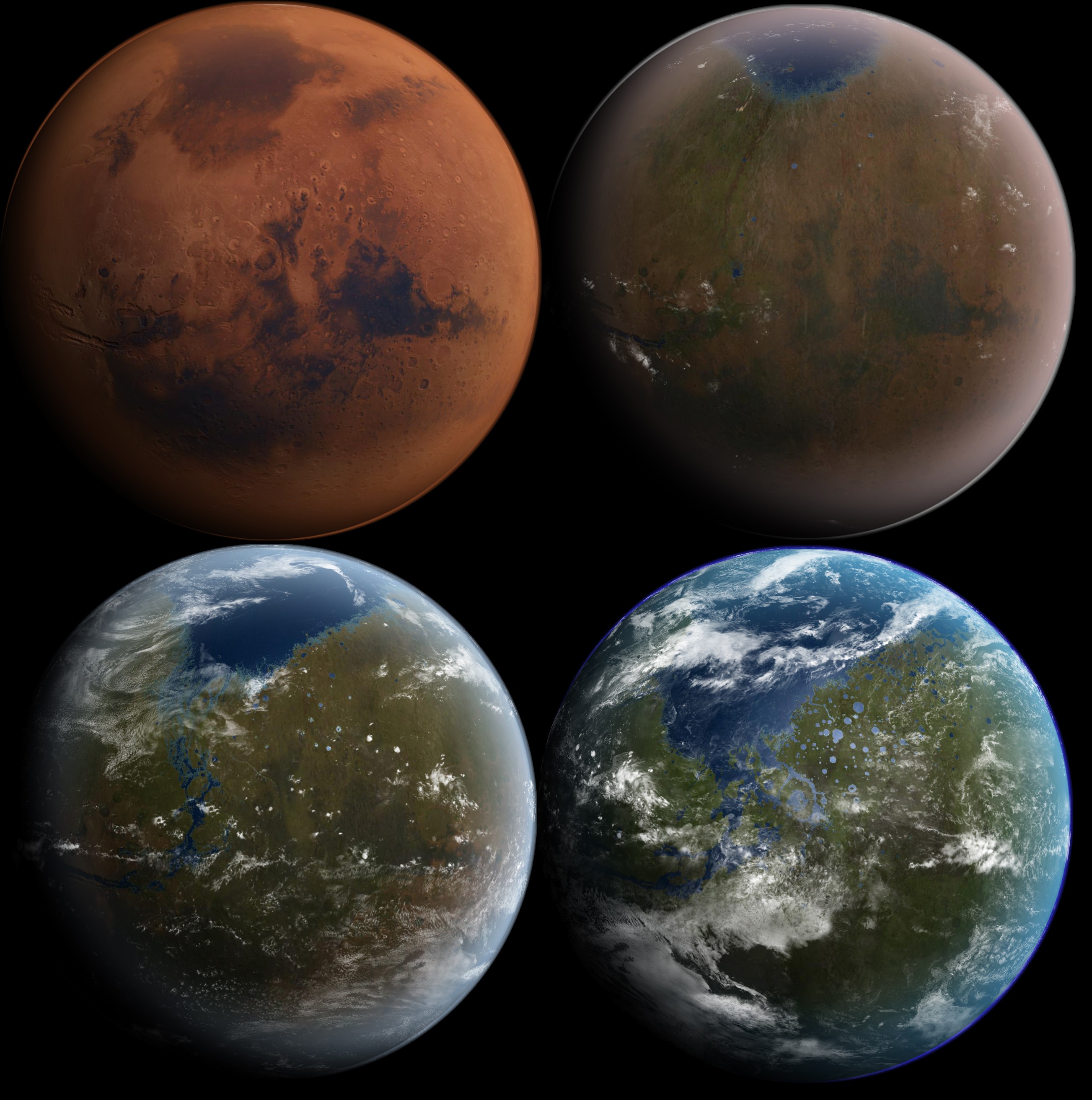
Stages of the terraforming of Mars. Wikipedia
Ilon Mask described his plans for the colonization of Mars. The third stage will be the delivery of equipment for the construction of Mars Base Alpha and the construction of a plant for the production of rocket fuel. For people, geodesic domes of glass panels with carbon fiber frames will be built. Such domes will protect the colonists from the winds during dust storms. Over time, air will be pumped into the houses under pressure, which will allow people to live in a pleasant ecosystem surrounded by plants.
As in the case of the Moon , there is an assumption that it will be more convenient to live below the surface. Mars has lava tubes and caves that can be used for this purpose. The soil will also protect against radiation, as well as protect people and equipment from meteor shower.

At the moment, there are no ready-made technologies for building construction on Mars. In fact, everything is limited to any sketches and plans, the details of which are less than in the case of the colonization of the Moon. To get new ideas, NASA held a competition in 2015, among the participants of which: architects, engineers and scientists. All projects must comply with one point: to create some or all of the elements, you must use a 3D printer. Also in the conditions of prescribed area of housing at least 93 square meters and the availability of life support systems, plumbing fixtures, places for cooking and sleeping places.
One of the best ideas was the LavaHive project. This is an inflatable system, some elements of which will need to be printed. One of the useful properties of such a building is the ability to blow, collect and transport.
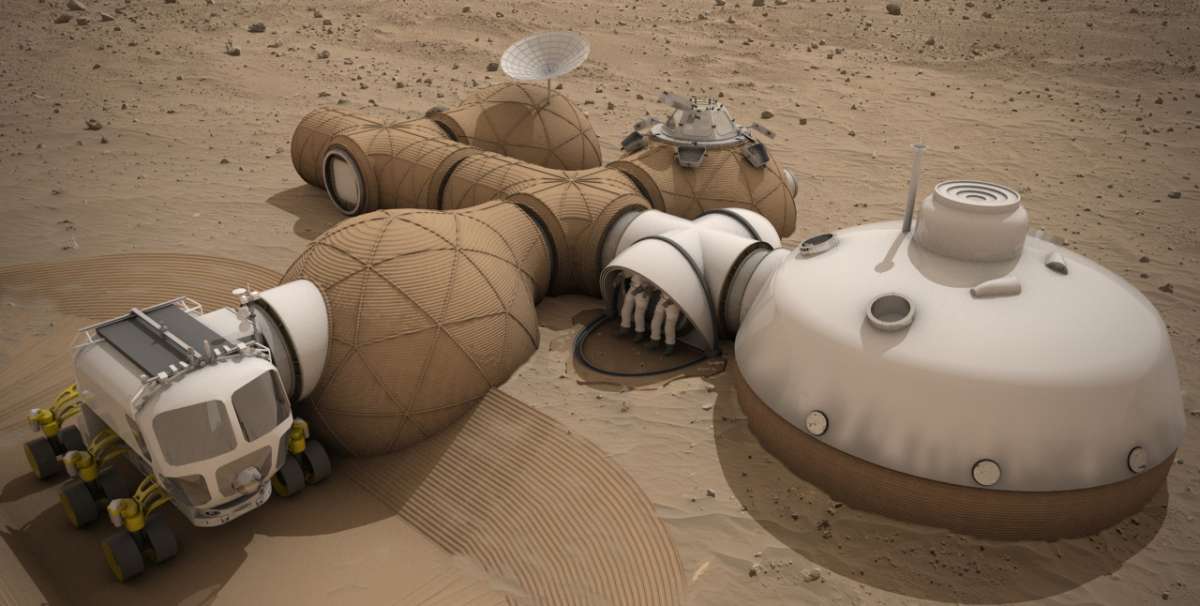
Less at first glance, a realistic project - Staye A While. The building is proposed to be placed underground under the frozen sea near the equator.
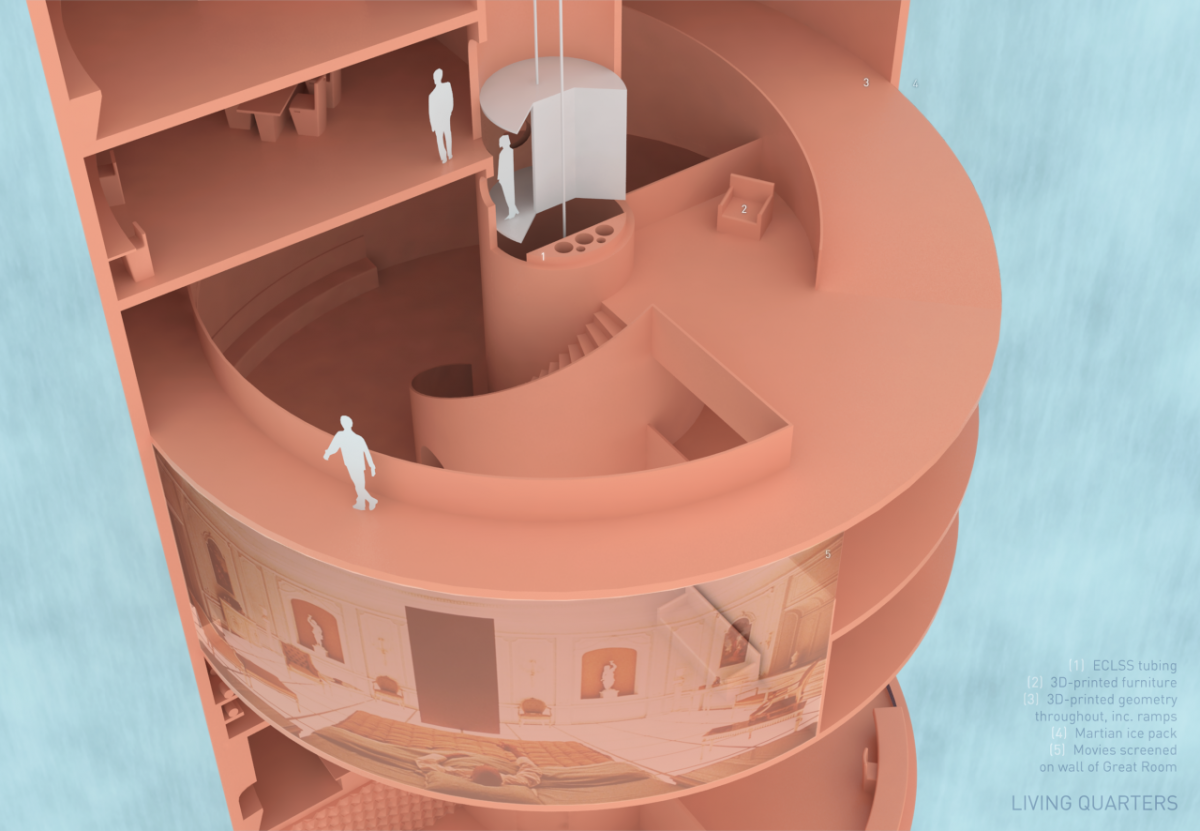
Today we have technologies that allow, with a high degree of probability, to deliver cargo to Mars. What about people - there are still many problems to be solved, including radiation, in order to talk about such a long flight, according to the results of which the crew will remain alive and healthy. On the planet itself there are materials that are in theory suitable for the construction of buildings with the help of the same 3D printers, but this technology will also have to be tested to speak of its effectiveness. Taking into account the time between possible launches of ships, a colony should provide itself independently for about three years. Taking along provisions, materials and tools for such a period would be wasteful, so it is important to think about farming on Mars.
When will we fly to Mars? What will the colonist's home look like? There is no exact answer yet neither at me, nor at NASA, nor at Roskosmos.
The red planet is closest to Earth, except for Venus. In just 9 months, you can reach your destination. Mankind is developing technologies that will get to Mars, create a permanent base there, set up mining operations and even terraform this planet in order to simplify the lives of people on it.

The USSR studied the Red Planet in the framework of the Mars and Phobos programs. The Mars-1 spacecraft, launched on November 1, 1962, was the first to be launched on a flight path to Mars. At a distance of 106 million kilometers from Earth, the device last contacted, but its task was to collect data about the flight itself: the intensity of cosmic radiation, the distribution of meteoric matter, the strength of the Earth’s magnetic fields and the interplanetary medium. The Mars-2 orbiter studied the planet from orbit for more than 8 months. The Mars-3 descent vehicle became the first vehicle to successfully land on the planet's surface, although it shut down after 20 seconds. The Mars-2 and Mars-3 orbiters helped to investigate the properties of the surface and atmosphere of Mars according to the nature of the radiation, to identify thermal anomalies, and to measure the temperature of the north polar cap. The vehicles with serial numbers 4, 5, 6, 7 took photographs of the surface, including color ones, and continued to collect various data about the planet, including the chemical composition of the atmosphere.
')
From 1962 to 1972, NASA sent 10 spacecraft to Mars and Venus as part of the Mariner program. Mariner 4 flew at a distance of 9,846 kilometers from the surface of the planet and became the first to photograph Mars at close range. The devices Mariner 6 and Mariner 7 flew even closer, at a distance of less than 3.5 thousand kilometers from the planet. Mariner 9 was the first artificial satellite of another planet and photographed about 85% of the surface. In the 1970s, NASA launched the Viking program. Two vehicles were sent in 1975 and worked first until 1978, the second until 1980. Descent vehicles took soil samples to analyze for the presence of life.
In 1996, NASA sent a Mars Global Surveyor unmanned research station. In 2005, this station became the first spacecraft to film another device in an extraterrestrial orbit. After almost ten years of work, the connection with the device has been lost.
The Mars rover Sojoner worked on Mars in 1997 for almost three months, from 2004 to 2010 he worked as a Spiritist. Now the planet is being studied by Opportunity , which was supposed to work only 90 days, but has been functioning for several years since January 2004, and Curiosity , which came to the surface in August 2012.
Today, Mars is the most studied planet in the solar system after Earth. But for his colonization to be solved still a lot of questions.

American astronomer Karl Sagan at the layout of the automatic viking station "Viking"
Flight
To live on Mars, you need to fly to it. To send people there immediately would be a huge mistake, so it is supposed to deliver various equipment to the planet, which will later allow to deploy residential buildings, modules for growing plants, a rocket fuel plant (you need to return to Earth someday!)
In the USSR in the early 1960s, they began to develop a heavy interplanetary ship. In parallel, two projects were developed. The first Maksimov apparatus with a crew on board had a living compartment, a worker with a gateway for going into outer space, a descent module, an adjustment propulsion system. The Feoktistov spacecraft assumed the assembly of a spacecraft in orbit, a crew of 4 people, a descent vehicle. The project was closed because of the moon race.
In the USA, from 2004 to 2010, they worked on the “Constellation” program, under which they planned manned flights to Mars. One of the targets was the new manned research ship Orion.
The American company SpaceX is working on the Interplanetary Transport System. The project involves the creation of reusable space transport to deliver people to Mars. The system will consist of a returnable launch vehicle, a spacecraft and an interplanetary vehicle for refueling.
One of the main threats of a manned flight to Mars is radiation. Solar flares, guaranteeing an increased dose of radiation, may have to wait in special rooms. Full protection of the spacecraft can greatly weight it, as well as increase the cost of the flight. But there is another way - to create a magnetic field that will need to be turned on during strong solar flares.

It is important to say about the failed program Mars One, which until 2015 was one of the most famous thanks to an open set of people willing to fly to Mars and a huge amount of PR on the Internet, in the media and on television. Five years after starting work on it, it turned out that there was no money, no technical solutions for the project.
Agriculture
Cargo delivery to Mars in any case will remain a rather expensive task. Between the windows for the flight passes 26 months. The flight itself takes 9 months, plus you need time to work out the details, to compile and collect the cargo. Therefore, in order to create a colony, the most autonomous existence of people on the planet is most important.
One of the main problems to be solved is the development of agriculture . For more than fifty years, scientists and cosmonauts have been researching the effects of microgravity on seeds, thinking through the possibilities of creating farms at space stations and other planets. In 1960, together with Belka and Strelka, the seeds of corn, wheat, peas and onions were sent into orbit, and in 1974, the Oasis plant for plant cultivation was installed at the Salyut-4 orbital station.

"Oasis-1" in the Memorial Museum of Cosmonautics. A source
Cosmic crop production is not limited to experiments in microgravity. It is necessary to understand how plants will behave in a different soil from the earth and in an atmosphere with a different composition. Meteorite soil, as it was found out in 2014, is suitable for growing asparagus and potatoes, but it must be ground for this purpose. Mars has a lot of sand and dust, it simplifies the task. But there is another problem: heavy metals.
Since 2013, Dutch scientists have grown plants in imitation of the Martian soil. The content of heavy metals in peas, radish, rye and tomatoes turned out to be safe for humans. Research on other crops, such as potatoes, is ongoing.
The atmosphere of Mars is 95% carbon dioxide, which will help maintain vegetation.

Researcher Wager Vamelink inspects plants grown on simulated Martian soil. Photo: Joep Frissel / AFP / Getty Images
In addition to actually feeding people, plants, algae and microorganisms can play a special role in terraforming the planet - creating suitable conditions for human life on it.
Terraforming
Even today, Mars is partially suitable for human life due to a number of characteristics with special equipment, including a pneumatic suit. The day on Mars lasts 24 hours 39 minutes 35. There is a change of seasons on the planet, although on Mars this is twice as long. An atmosphere with a density of 0.007 Earth gives some protection from solar and cosmic radiation. There definitely is ice, and possibly - water in liquid form .
In the process of terraforming it is possible to solve several problems. First, this is an increase in atmospheric pressure, at which water will exist in a liquid form. Now the water on the planet boils at +10 degrees, that is, from the ice turns into steam immediately. Also, with increasing pressure, it will be possible to use an altitude compensation suit instead of spacesuits.
Secondly, on the planet, you can raise the temperature to 10-20 degrees Celsius. Now the average temperature is −50 ° C and ranges from −153 ° C at the pole in winter and to over +20 ° C at the equator at noon.
Thirdly, you need to create a biosphere - to populate the planet with plants, fungi, bacteria.

Dark stripes - the estimated flow of liquid water on Mars. Photo: NASA
At the moment there are a number of ways that, as scientists assume, will allow you to change Mars. On the surface of the planet, for example, asteroids can be brought down to warm the atmosphere and fill it with water and gases. Artificial satellites can be placed in orbit, which can focus sunlight on its surface to heat up.
In order to allocate greenhouse gases on Mars and obtain the necessary substances in large volumes from those already on the planet, they propose to use extremophiles - these are living beings, including bacteria and microorganisms, which are able to live and reproduce in extreme conditions. Some 34 species of lichens and cyanobacteria were able to adapt to the simulated Martian conditions and begin the process of photosynthesis.
Ilon Mask suggested that the fastest and most effective way to terraform Mars is a few nuclear explosions on its surface in certain regions. But radiation contamination in this case can negate the result.
At the moment, there is no exact solution for the problem of terraforming, all the listed methods are only assumptions.

Stages of the terraforming of Mars. Wikipedia
Dwelling
Ilon Mask described his plans for the colonization of Mars. The third stage will be the delivery of equipment for the construction of Mars Base Alpha and the construction of a plant for the production of rocket fuel. For people, geodesic domes of glass panels with carbon fiber frames will be built. Such domes will protect the colonists from the winds during dust storms. Over time, air will be pumped into the houses under pressure, which will allow people to live in a pleasant ecosystem surrounded by plants.
As in the case of the Moon , there is an assumption that it will be more convenient to live below the surface. Mars has lava tubes and caves that can be used for this purpose. The soil will also protect against radiation, as well as protect people and equipment from meteor shower.

At the moment, there are no ready-made technologies for building construction on Mars. In fact, everything is limited to any sketches and plans, the details of which are less than in the case of the colonization of the Moon. To get new ideas, NASA held a competition in 2015, among the participants of which: architects, engineers and scientists. All projects must comply with one point: to create some or all of the elements, you must use a 3D printer. Also in the conditions of prescribed area of housing at least 93 square meters and the availability of life support systems, plumbing fixtures, places for cooking and sleeping places.
One of the best ideas was the LavaHive project. This is an inflatable system, some elements of which will need to be printed. One of the useful properties of such a building is the ability to blow, collect and transport.

Less at first glance, a realistic project - Staye A While. The building is proposed to be placed underground under the frozen sea near the equator.

Today we have technologies that allow, with a high degree of probability, to deliver cargo to Mars. What about people - there are still many problems to be solved, including radiation, in order to talk about such a long flight, according to the results of which the crew will remain alive and healthy. On the planet itself there are materials that are in theory suitable for the construction of buildings with the help of the same 3D printers, but this technology will also have to be tested to speak of its effectiveness. Taking into account the time between possible launches of ships, a colony should provide itself independently for about three years. Taking along provisions, materials and tools for such a period would be wasteful, so it is important to think about farming on Mars.
When will we fly to Mars? What will the colonist's home look like? There is no exact answer yet neither at me, nor at NASA, nor at Roskosmos.
Source: https://habr.com/ru/post/398777/
All Articles